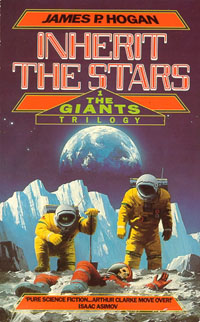



| INHERIT THE STARS James P. Hogan |
Rating: 5.0 High |
||||
| New York: Ballantine Books, 1977 | ISBN 0-345-28125-X | 216pp | SC | $3.95? | |
| London: Grafton Collins, 1989 | ISBN 0-58620487-3 | 239pp | SC | $3.95? | |
In A. E. van Vogt's famous novel The Voyage of the Space Beagle, there is a character who practices what van Vogt called "nexialism": a sort of inspired deductive ability that spans all scientific disciplines and permits a practitioner to synthesize hosts of disparate details into a coherent picture.
Victor Hunt, the hero of Inherit the Stars, is much like this. Trained as a theoretical physicist, he nevertheless can reason effectively in geology, biology, chemistry — indeed, any scientific field, and often more effectively than the experts in that field.
That's useful, for Hogan's tale is one vast intellectual jigsaw puzzle. Its genesis, I believe, was the real observation that the far side of the Moon is more heavily cratered than the side that faces us. What if, Hogan wondered, that bombardment was intentional? From that speculation, he extrapolated an earlier human technological civilization that did not originate on Earth — and much more. The story describes Hunt's quest to uncover and understand the many novel and seemingly contradictory pieces of evidence to form a complete, coherent picture that leads him to a shattering conclusion.1
Hogan says on his Web site that this was his first book. It began when he was a technical sales representative for Digital Equipment Corporation. After he watched 2001: A Space Odyssey... But let him tell the tale in his own words:
This was what started it all off — the first book I wrote. It began as an office bet while I was working in computer sales. |
Although there was much that I enjoyed about the movie "2001", I never understood the ending. I listened to all kinds of ingenious interpretations, but they were all mutually contradictory, and I suspected existed more in the eyes of the people doing the interpreting than in anything objective out there, that they were seeing. So one day I was complaining about this in the office. Probably more to shut me up because there was work to do, one of the other sales engineers said what we all say at some time or other: "If you think you can write something that makes more sense, do it." I said okay I would, and a bunch of us ended up betting on whether I'd get it published. Well it was, and I was launched into a completely new career as a consequence. |
The punch line to it all was that years later, after I had moved to the U.S. and was living in Massachusetts, I had dinner with Judy Lynn Del Rey and Arthur C. Clarke in Boston one night and was finally able to ask him — the ultimate source — "What did the ending to that movie mean?" And Arthur's answer was, "I haven't the faintest idea." It was based on his short story The Sentinel, and apparently none of the Hollywood people involved could agree on how to end it. Arthur walked away and left them arguing over it. "And that was what they came up with," he said. "I've never really understood it either." |
Before finishing Inherit the Stars, I realized that there was another story to be told — concerning an extinct alien race, relics of which had been found in the course of further lunar exploration. The sequel, The Gentle Giants of Ganymede, followed in 1978, and the "Giants" series eventually grew to include Giants' Star and Entoverse. The first three novels have been packaged into a single volume as The Minervan Experiment, by the Nelson Doubleday Book Club, and The Giants Novels, by Ballantine/Del Rey. |
For some, this novel (and the other two parts of Hogan's "Giants Trilogy" that followed it) may contain too much exposition of scientific detail to be enjoyable. I lapped it up, on first reading; and despite having important parts of its thesis2 invalidated by later discoveries, it remains in my top rank of hard science fiction tales. I recommend it unreservedly,3 especially to new readers of SF.

 To contact Chris Winter, send email to this address.
To contact Chris Winter, send email to this address.